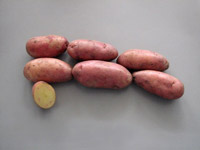2008 – International year of the Spud

Photo: IPC
Welcome to 2008, Chinese Year of the Rat, Australian Year of the Scout, European Year of Intercultural Dialogue, International Year of the Planet, International Year of Sanitation, and, most significantly, International Year of the Potato (IYP). Suggested by Peru, where pre-Columbian farmers in the Andes first began to cultivate the crop, the International Year of the Potato was officially launched on 18 October 2007 at a glittering, star studded launch ceremony (high-ranking United Nations officials, representatives of country missions to the UN, members of the IYP Informal International Steering Committee, representatives of the US “potato community”, and 300 schoolchildren from the Washington DC area) at the United Nations Headquarters in New York. The event was attended by Kevin Dowling, Counsellor, Mission of Ireland to the United Nations, who addressed the attendee’s and announced that Ireland is providing €200,000 in core funding for the three years 2007-2009 to the International Potato Centre in Peru and a further €320,000 for a research project in Malawi.
According to the Cambridge World History of Food the earliest archaeological evidence of potato production consists of “fossilized remains of possibly cultivated tubers found on a cave floor in Chilca Canyon” in the Lake Titicaca region of Peru and Bolivia “suggest that the potato was cultivated at least from about 7,000 years ago, although it is not possible to tell whether these were wild, ‘dump heap,’ or already garden acquisitions”.
It wasn’t until the mid-sixteenth century that the potato made its way to Europe and by the late eighteenth century it had gained widespread acceptance in Ireland, becoming a dietary staple. Average yields of potatoes were 6 tons per acre, in contrast with less than 1 ton per acre for wheat or oats, thus providing sustenance for significantly more people with less acreage. Farmers set up ‘lazy beds’ (small banks of earth with drainage channels between them), still visible throughout the Irish countryside today, fertilized by manure or seaweed, in order to more efficiently cultivate them. By 1840, the country’s population had swelled to eight million people – largely due to the potato.
The 1840’s, however, saw the arrival of the potato blight, caused by a fungus Phytophthora infestans. With two consecutive blight seasons (45 & 46 and again in 48), no alternative food crop for tenant farmers, continuing exportation of Irish grain (boatloads of home-grown oats and grain departed on schedule to England throughout the famine), the English policy of laissez-faire and soaring eviction rates, large swathes of the Irish countryside were decimated, with the population left landless and in dire poverty.
The French sociologist, Gustave de Beaumont wrote (prior to the famine): “I have seen the Indian in his forests, and the Negro in his chains, and thought, as I contemplated their pitiable condition, that I saw the very extreme of human wretchedness; but I did not then know the condition of unfortunate Ireland…In all countries, more or less, paupers may be discovered; but an entire nation of paupers is what was never seen until it was shown in Ireland.”
Over the course of the famine almost one million people died from starvation or disease. Another million or so emigrated, mostly to Britain, Canada and America, where they faced further hardships. Of those who left, many died on board the transport ships (coffin ships) due to horrific conditions.
The population of Ireland has never recovered, and although our per capita potato consumption of 293g per person per day is still quite high in a European context, we are no longer the number one potato eaters in the world. In fact, more potatoes per head are consumed in Britain, Poland and Russia, among others, with Belarusian’s breaking all records at 926g.
This entry was posted on Thursday, January 3rd, 2008 at 2:46 pm. It is filed under History and tagged with 2008, famine, History, International year of the potato, Ireland, Potato, potatoes, UN.
You can follow any responses to this entry through the RSS 2.0 feed.



